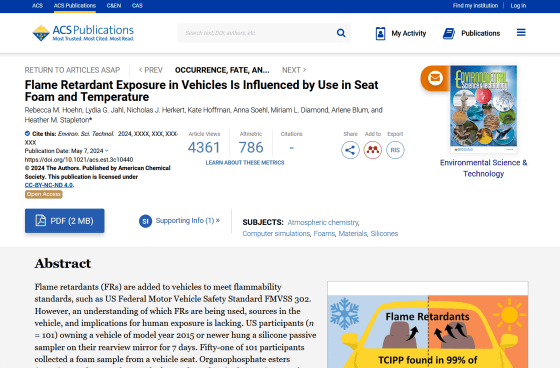When you breathe in a car, you risk inhaling harmful substances that can cause cancer.

Many people use cars to commute to work, take their children to and from school, or travel, but few may be aware of the risk of harmful substances floating around inside the car. A new study conducted by
Flame Retardant Exposure in Vehicles Is Influenced by Use of Seat Foam and Temperature | Environmental Science & Technology
https://pubs.acs.org/doi/10.1021/acs.est.3c10440

Study: You're Breathing Potential Carcinogens Inside Your Car - Green Science Policy Institute
https://greensciencepolicy.org/news-events/press-releases/study-youre-breathing-potential-carcinogens-inside-your-car
A Serious Hidden Risk Is Built Into Virtually Every Car, Scientists Warn: ScienceAlert
https://www.sciencealert.com/a-serious-hidden-risk-is-built-into-virtually-every-car-scientists-warn
In the United States, safety regulations introduced by the National Highway Traffic Safety Administration (NHTSA) in the 1970s require the addition of flame-retardant materials to car seats to prevent fires, but these flame-retardant materials can contain carcinogens and their fire-prevention benefits are unclear.
The research team recruited 101 American subjects who drive cars manufactured after 2015, and had them hang a silicon sampler on their rearview mirror for seven days to analyze the chemicals floating around inside the car from February to May. About half of the subjects were sent a silicon sampler in July and August to undergo the same test, and samples of seat foam taken from the car's seats were also analyzed.
Of the vehicles analyzed, 49 were gasoline-powered vehicles, 26 were electric vehicles, and 26 were hybrid vehicles. By country of manufacture, 39 were from the United States, 24 from Japan, 8 from Mexico, 7 from Germany, 5 from South Korea, 4 from Canada, and 14 from other/unknown countries.

The study found that
Additional organophosphate flame retardants, such as tris(1,3-dichloro-2-propyl) phosphate (TDCPP) and tris(2-chloroethyl) phosphate (TCEP), were also found, which may also cause harm to the nervous and reproductive systems .
These potentially harmful chemicals also leak into the air more easily during hotter months, the team found, with air concentrations of these chemicals two to five times higher in summer than in winter.

'Our study finds that car interior materials release harmful chemicals into the air inside cars,' said Rebecca Horn of Duke University, lead author of the study. 'Given that the average driver spends about an hour each day in their car, this is a major public health issue, especially for drivers with long commutes and for child passengers who breathe in more air than adults.'
'Flame-retardant materials may be increasing the risk of cancer among firefighters,' said Patrick Morrison, president of the International Association of Fire Fighters. 'Filling products with these harmful chemicals does not prevent fires in most applications. Instead, it makes fire smoke more toxic for victims and especially firefighters and emergency responders. We urge NHTSA to update the flammability standards so that they can be met without the need for flame-retardant chemicals in vehicles.'
Related Posts:







